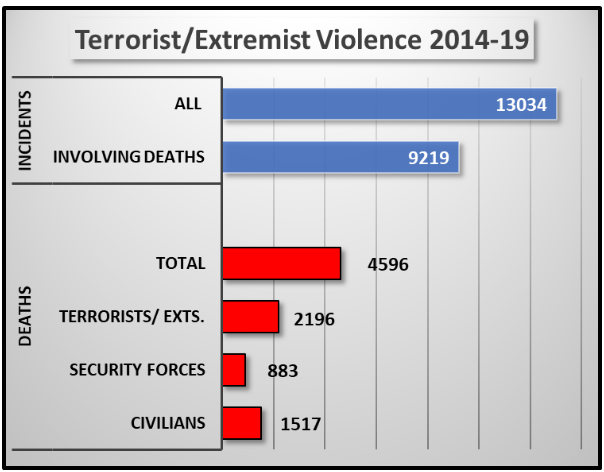
In a series of whistle-stop rallies across the country, PM Modi repeatedly claimed that in his role as the chowkidar (watchman), he has ensured better security for the citizens. His government has adopted “zero tolerance” towards terrorism, he claimed. He repeatedly claimed that the air strikes on Balakot, Pakistan, showed a strong response to terrorism.
According to a calculation by a Hindi newspaper, these themes dominated his speeches in 35 rallies out of 42 that he addressed in the last fortnight. Apparently, Modi and hence the BJP, have now made ‘national security’ the cornerstone of their campaign. Clearly, it is an attempt to make full use of the tragedy at Pulwama and the Balakot air strikes.
But are these claims correct? No, if you look at the figures of terrorist or extremist attacks for the past five years. According to a response given by the state home minister to a question asked in Lok Sabha on February 5, 2019, for details till 31 December 2018, and adding the data for 2019 (from South Asia Terrorism Portal), there were over 13,000 incidents of terrorist or extremist violence in the country between 2014 and April 2019. Out of these, some 9,000+ incidents involved deaths.

In all, during this period, 4,596 persons were killed which included 1.517 civilians, 883 security forces and 2,196 terrorists/extremists.
This is hardly a picture of zero tolerance towards terrorism/extremism! In fact, it shows a rather perilous situation with nearly seven violent incidents and over two people getting killed every day.
It may be thought that all this probably refers to Jammu and Kashmir or some such trouble-spots. But that’s not correct.
It is true that terrorism or militancy related incidents are the most in J&K, making up nearly one third of deaths and about a quarter of all incidents involving deaths. But the remaining incidents (some 7,000+) were spread over 20 states. Most north-eastern states saw such incidents (dubbed ‘extremist’ in government language) and resulting deaths. Besides these, there were such incidents in many other parts of the country arising from Naxalite activities (dubbed ‘left-wing extremists’). Altogether, over 20 states have witnessed such incidents every year in the period of Modi’s rule.
New ‘Terrorism’
Modi’s rule has also seen the rise of a new form of violence that can only be categorised as terrorism – because it is meant to terrorise particular sections of society. This is the barbaric incidents of lynchings by mobs. According to data compiled by IndiaSpend, there were 123 incidents of mob lynching leading to 46 deaths and injuries to 295 people between 2014 and 2019. Most of the victims were either Muslims or dalits. Most cases were perpetrated by cow vigilantes, on the pretext of protecting cows or on rumours of beef consumption. In some cases, mere suspicion of strangers abducting children led to targeted attacks, or even travelling people with no criminal intent were targeted, fuelled by rumours. Surely, this is also terrorism, causing as they do, great fear among large sections of population.
Another form of terror that has found deadly life under the Modi regime is the assassination of well-known personalities who speak against religious fanaticism. This has happened mainly in Karnataka and Maharashtra where Gauri Lankesh, Dabholkar, Pansare and Kalburgi were murdered by Hindu terrorist outfit Sanatan Sanstha or its network affiliates. This organisation was running training camps, they had arms caches, hit lists and a whole network of followers committed to such activities. If Indian Mujahideen or other such organisations can be called Islamic terrorists then what should Sanatan Sanstha and their kin be called?
And, of course, it can’t be forgotten that armed religious processions that enter particular localities on religious festivals and shout provocative slogans also spread terror – because often such shows of strength organised by Hindu groups lead to communal violence, arson and killings. During Modi’s first four years of rule (2014-17), over 3,000 such incidents have taken place in which over 400 people were killed and over 9,000 injured as per official data available till 2017 end only.
So, the Modi years are far from being an era of zero tolerance towards terrorism. This period will go down in history as that in which Indian people’s unity has been put to one of the most severe strains due to official backing of terror against minorities and dalits/Adivasis. And, as we saw earlier, it is also a period when violence in J&K has increased, while it continues in North-East and elsewhere.
Modi’s desperate claims of muscular responses and zero tolerance appears more bluster in the face of a losing battle.




